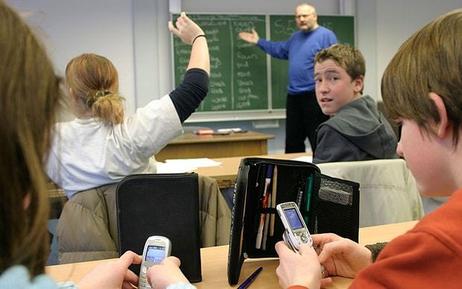As students in public school today are exposed to endless technological advances, the use of cell phones seems to be an often ignored modern-day issue. While cell phones certainly offer students increased communication abilities, providing students with a tool for added safety and parent contact, many public school leaders assert that cell phones are a severe distraction in the educational process. Whether students are talking in the halls, on the phone in the restroom facilities, or texting during class, phones are proving to be a significant distraction in many studentsŌĆÖ educational process.
To counteract the negative implications, many public schools have even issued a ban on the use of cell phones while on campus. Upon the onset of these drastic measures, a fairly glaring debate has arisen between school leaders and many community members.
The Ringing Debate
As school leaders are striving to improve student performance and the overall student learning experience, schools across the country are enforcing strict policies regarding cell phones. Specifically, the entire city of New York issued a general ban against cell phones in their cityŌĆÖs public schools.
According to eSchool News, a group of parents was so outraged by this ban that they have taken legal action against leaders, and they are suing the city for violating student rights to possess cell phones: ŌĆ£The eight parents' lead lawyer, Norman Siegel, said the lawsuit was filed against the city's Department of Education, schools Chancellor Joel Klein, and Mayor Michael Bloomberg after they ŌĆścallously refusedŌĆÖ to discuss or listen to concerns about the ban.ŌĆØ
The parents issuing the lawsuit are outraged that schools are banning cell phones, as the parents believe that the phones provide their children with vital tools of communication, especially if needs or emergencies arise. Furthering the argument, Siegel states that ŌĆ£the cell-phone policy, in effect since 1988, is illegal and unconstitutional because it interferes with parents' rights to oversee their children's safety.ŌĆØ
In defense, eSchool News reports that ŌĆ£city education officials, with Bloomberg's support, have said cell phones are disruptive and distracting, can be used for cheating on tests, and can be used to coordinate gang activity.ŌĆØ The New York City ban seems to illuminate the diverse arguments in the cell phone ban debate, as schools and community members are trying to find a common ground of agreement.
This video from New EdTech Classroom offers a rationale for allowing the use of cell phones in school.
The Pros of Cell Phones in Schools
Pagers and cell phones were initially banned and regulated in schools due to the common occurrence that these devices were being used for drug and/or gang activities. As technology has become more accessible for all students, however, parents and students assert that phones are now essential tools that enhance safety and communication: ŌĆ£parents have increasingly lobbied boards to change policies primarily based on the argument that phones will make students and schools safer in light of national tragedies.ŌĆØ
In reflecting on the occurrences of school shootings, car accidents, or threatening situations, parents want to ensure that their child is provided with a tool for support and contact in case they are faced in a situation that may cause personal harm or danger.
The Cons of Cell Phones in Schools
According to the (NSSSO), cell phones have been an increasingly negative disruption in schools: ŌĆ£We have opposed policies allowing or encouraging students to have cell phones and pagers in school. On a day-to-day basis, they are disruptive to the educational environment. This also has been the general position of many school districts over the years.ŌĆØ
Adding to this, the NSSSO argues that allowing cell phones for safety reasons is inaccurate. As they explain, ŌĆ£Changing policies under the guise of cell phones being a crisis tool for student safety is, in our opinion, a knee-jerk reaction and is not ŌĆśthe answerŌĆÖ to school crisis preparedness that some may believe it to be.ŌĆØ In fact, school and security officials frequently report that students falsely call in bomb threats or reports of threats on their cell phones as an over-reaction or as a prank; in such cases, these cell phones can force the entire evacuation of a school, while also making it nearly impossible for security teams to try and figure out where the call was placed, and which student(s) made the call.
This video explains how banning cell phones in school allows students to focus.
Adding to this, in examining the potential distractions that cell phones pose in schools, ŌĆ£school disruptions can come in a number of forms. Ringing cell phones can disrupt classes and distract students who should be paying attention to their lessons at hand. Text messages have been used for cheating. And new cell phones with cameras could be used to take photos of exams, take pictures of students changing clothes in gym locker areas, and so on.ŌĆØ
Ultimately, while phones may provide students with a means for communication and support, schools and community members across the country are struggling to find a common ground and agreement regarding how to best support a positive environment and experience for all learners in the public school.
Cell phones morph into smartphones
The notes: "TodayŌĆÖs students are digital natives. Nearly three out of four teenagers have access to a smartphone, and so many students take them to school every day. For some teachers, itŌĆÖs probably more uncommon to see a student without one than with one."
The huge number of educational apps available in both Android and Apple formats is another gamechanger. Add to that podcasts on virtually all the usual academic topics and subjects, and you can see why what we used to refer to as an annoyance, i.e., the cell phone of the 2000s has morphed into another highly customizable, personal tool for delivering learning. Smartphones proved their effectiveness during the pandemic of 2020-2021 by keeping students forced to take classes online involved with their learning. Each student learns in her own individual way. Smartphones accommodate those individual learning styles.
Questions? Contact us on Facebook. @publicschoolreview













